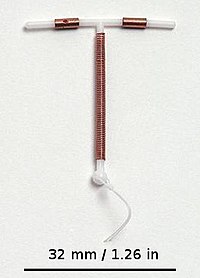
Photo from wikipedia
OBJECTIVES To compare the expulsion rate at 6 months after postplacental insertion by intrauterine device (IUD) type. STUDY DESIGN This prospective cohort included participants with a postplacental IUD inserted after vaginal… Click to show full abstract
OBJECTIVES To compare the expulsion rate at 6 months after postplacental insertion by intrauterine device (IUD) type. STUDY DESIGN This prospective cohort included participants with a postplacental IUD inserted after vaginal or cesarean delivery, aged 18-45 and ≥24 weeks' gestation. Study enrollment took place after IUD selection and insertion. Participants returned for a postpartum visit and received a short message service survey regarding IUD expulsion, removal, vaginal bleeding and breastfeeding weekly from weeks 0 to 5 and on weeks 12 and 24 postpartum. Multivariable logistic regression examined 6-month expulsion rate by IUD type adjusting for variables that differed between the groups at baseline and in the bivariate analyses. RESULTS Of 114 participants, 75 (65.8%) chose a levonorgestrel 52-mg IUD and 39 (34.2%) chose a copper IUD; 58 (50.9%) had a vaginal delivery, and 56 (49.1%) had a cesarean delivery. Groups were similar except that copper IUD users had a higher median parity (3 vs. 2, p=.03) and a higher proportion of senior residents compared to junior residents had performed insertion (46.2% vs. 22.7%, p=.02). The expulsion rate at 6 months was similar between the levonorgestrel and copper groups (26.7% and 20.5%, respectively; p=.38). Multivariable logistic regression also demonstrated that the odds of expulsion did not differ by IUD type (adjusted odds ratio 0.98, 95% confidence interval 0.22-4.48). CONCLUSION The expulsion rate at 6 months after postplacental insertion did not differ between the levonorgestrel and copper IUD type. IMPLICATIONS Prior studies demonstrate a wide range of expulsion after postplacental insertion, and recent data suggest a higher expulsion rate for the levonorgestrel compared to the copper intrauterine device. However, many studies did not control for patient-level factors or delivery route. We found that when controlling for these confounding variables, the expulsion rate at 6 months postpartum did not differ by intrauterine device type.
Journal Title: Contraception
Year Published: 2019
Link to full text (if available)
Share on Social Media: Sign Up to like & get
recommendations!